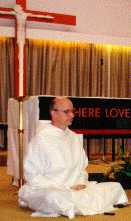
Roman Catholic Mysticism of "Contemplative Prayer"
"In Contemplative prayer we seek to become the person we are called to be, not by thinking of God but by being with God. Simply to be with God is to be drawn into being the person God calls us to be." John Main, OSB
John Main (1926-1982) believed that the contemplative experience is open to all and creates community. His genius was to recover and re-present a way into the contemplative experience for ordinary people within the Christian tradition. In the teaching of the Desert Fathers on pure prayer he found the practice of the mantra. Realising that this way of prayer could further the search of many modern people for a deeper spiritual life, he recommended two regular daily periods of meditation to be integrated with the usual practices of Christian life.
 Find a quiet
place. Sit down with your back upright. Sit still. Gently close your eyes and begin to
recite your prayer-word, or mantra, silently, interiorly and lovingly throughout the time
of your meditation: "Ma-ra-na-tha." Say it as four equally-stressed syllables.
It is an Aramaic word (which is the language that Jesus spoke) and it means "Come,
Lord." It is found in the Scriptures and is one of the earliest prayers in the
Christian tradition. Do not think about the meaning of the word. Just give your attention
to the sound of it thoughout the time of your meditation, from the beginning to the end.
Whenever distractions arise, simply return to your mantra. Meditate for 30 minutes each
morning and each evening, every day of your life. Father John always said: "Just say
your word." Meditation is a way of pure prayer marked by silence, stillness, and
simplicity.
Find a quiet
place. Sit down with your back upright. Sit still. Gently close your eyes and begin to
recite your prayer-word, or mantra, silently, interiorly and lovingly throughout the time
of your meditation: "Ma-ra-na-tha." Say it as four equally-stressed syllables.
It is an Aramaic word (which is the language that Jesus spoke) and it means "Come,
Lord." It is found in the Scriptures and is one of the earliest prayers in the
Christian tradition. Do not think about the meaning of the word. Just give your attention
to the sound of it thoughout the time of your meditation, from the beginning to the end.
Whenever distractions arise, simply return to your mantra. Meditate for 30 minutes each
morning and each evening, every day of your life. Father John always said: "Just say
your word." Meditation is a way of pure prayer marked by silence, stillness, and
simplicity.
(Photo: Father Laurence meditating at the 1994 John
Main Seminar.)
What does Roman Catholic Mysticism have to do with pagan Eastern Mysticism? Everything!
Look What Roman Catholic Mystics and Bhuddist Mystics are contemplating! Here is a short excerpt of a web page form the WCCM, outlining their eccumenical plans centering on their common spiritualistic meditaton exercises:
|
|
 |
In September 1994 His Holiness the Dalai Lama accepted the invitation
of Dom Laurence Freeman OSB, Director of The World Community for Christian Meditation, to
lead the annual John Main Seminar. "The Good Heart" became an historic event in
which the familiar concepts of inter-religious dialogue were enriched with fresh meaning. During the Good Heart seminar the Dalai Lama read and commented on the Gospels from his Buddhist perspective, as a monk, and as the spiritual leader of Tibetan Buddhism. Christians and Buddhists declared how their experience of friendship through meditation and dialogue together had changed their outlook and views of each other in profound ways. Published in many countries the book of The Good Heart has reinforced the growing awareness that the future of world peace cannot be ensured without meaningful inter-religious dialogue rooted in the compassionate power of meditative silence. |
| In February 1997 the Dalai Lama and Dom Laurence Freeman met again in Dharamsala to discuss how to build on what The Good Heart had achieved. Thus, the idea of The Way of Peace was born. The Way of Peace is a three-year initiative which will employ different means to express the urgent relevance to the world of the Buddhist-Christian dialogue, and inter-religious dialogue as a whole. These means are: Pilgrimage, Retreat, and Peace-Making. In December 1998 the first of these means -- Pilgrimage -- will bring a broadly-based group of monks, lay-people and scholars to India. They will visit a number of sacred sites in a spirit of prayer and friendship. Between December 13th and 16th they will join with the Dalai Lama and other Buddhists for three days of prayer and reflection at BodhGaya, the most sacred of Buddhist sites, where the Buddha was enlightened. This time will be focused by meditation together. There will also be reflection together of the different meanings of enlightment, liberation and salvation. |
This same mysticism is being imported into many Protestant Churches (including SDA). Does this bring to your mind the "three-fold union" of Apostate protestantism, Roman Catholicism, and Spiritulaism prophecied to occur during the final events of the great contoversy?
Through the two great errors, the immortality of the soul and Sunday sacredness, Satan will bring the people under his deceptions. While the former lays the foundation of spiritualism, the latter creates a bond of sympathy with Rome. The Protestants of the United States will be foremost in stretching their hands across the gulf to grasp the hand of spiritualism; they will reach over the abyss to clasp hands with the Roman power; and under the influence of this threefold union, this country will follow in the steps of Rome in trampling on the rights of conscience. ---The Great Controversy, page 588
Home Mission Statement Issues in SDA Education True Christian Education Counsels on SDA School Sports Reverence in the Sanctuary Proper Attitude in Prayer Theatrical Performances SDA Mysticism Holy Land Tours Josiah Reads and Weeps E-mail us at SAVE